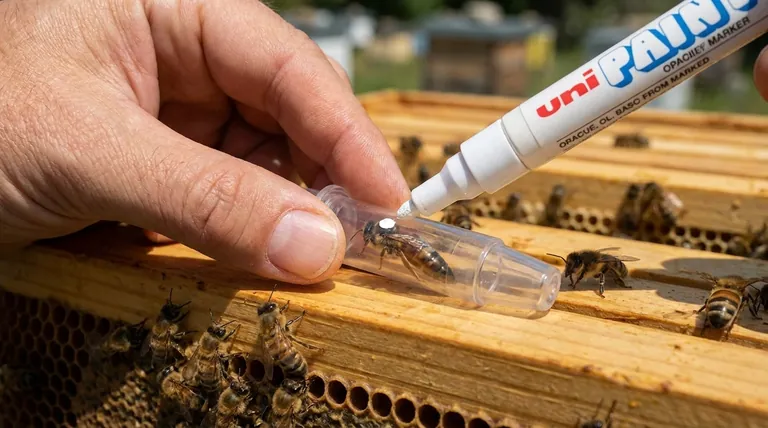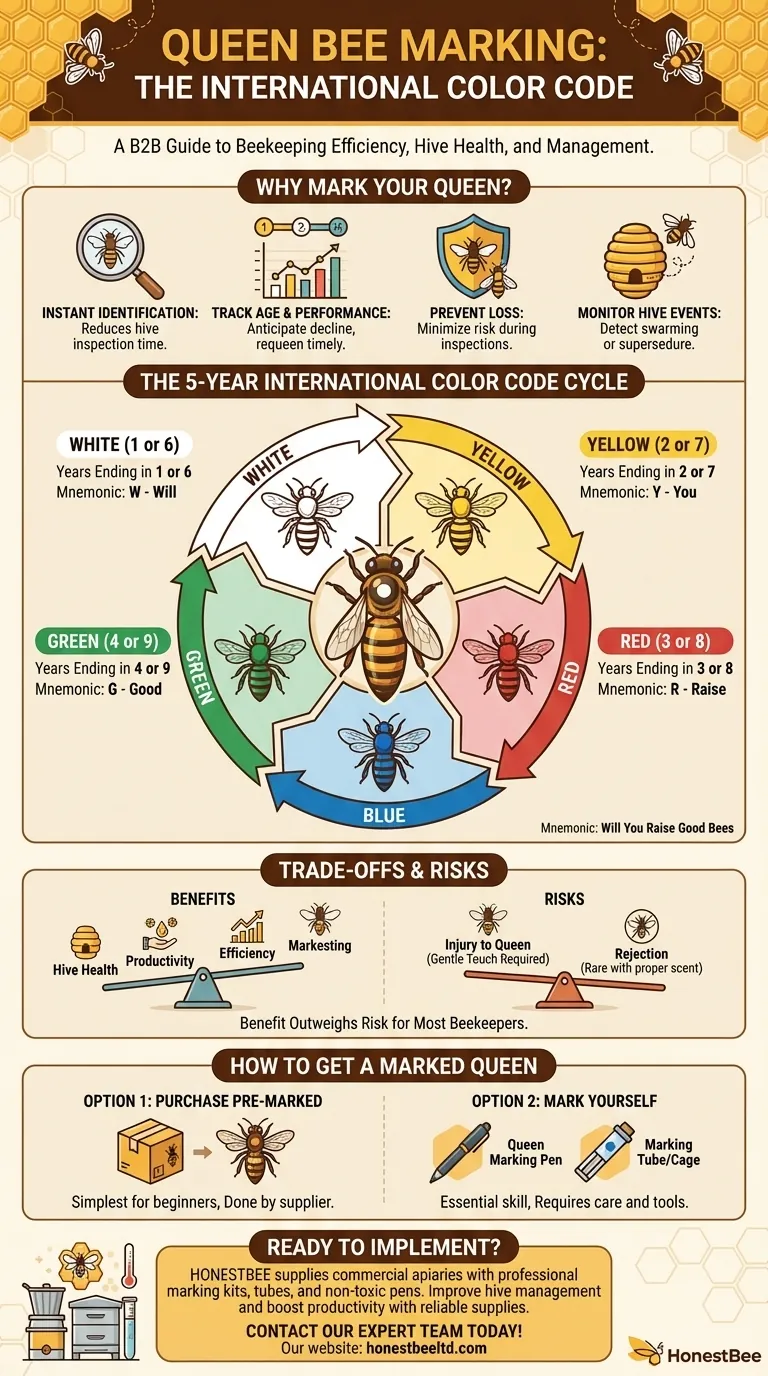The international color code for marking queen bees is a five-year rotating system based on the last digit of the year. The sequence is White for years ending in 1 or 6, Yellow for 2 or 7, Red for 3 or 8, Green for 4 or 9, and Blue for 5 or 0. This system allows a beekeeper to identify the age of their queen with just a glance.
Knowing the queen's age is not just about identification; it's a fundamental practice for managing hive health, productivity, and succession. The color on her back is one of the most important data points in your entire apiary.

Why Queen Marking is a Critical Beekeeping Practice
Marking your queen transforms a difficult task—finding one bee among tens of thousands—into a simple one. But its true value lies in the management insights it provides.
Instantly Identify the Queen
A small, bright dot of color on the queen's thorax (the middle section of her body) makes her stand out. This dramatically speeds up hive inspections, reducing the time the hive is open and minimizing stress on the colony.
Track Queen Age and Performance
A queen's egg-laying vitality is highest in her first two years and typically declines afterward. Knowing her age allows you to anticipate this decline and decide whether to replace her (requeen) before the colony's population and productivity suffer.
Prevent Accidental Loss
During an inspection, it's possible to inadvertently crush or injure the queen. A visible mark makes you constantly aware of her location, significantly reducing the risk of accidental loss.
Monitor Hive Events
If you find your marked queen is gone and a new, unmarked queen is present, you know the hive has either swarmed (the old queen left with part of the colony) or performed a supersedure (the workers raised a new queen to replace a failing one).
The International Queen Marking Color Code
The color code follows a repeating five-year pattern. A common mnemonic to remember the order is Will You Raise Good Bees.
Years Ending in 1 or 6: White
This corresponds to the "W" in the mnemonic.
Years Ending in 2 or 7: Yellow
This corresponds to the "Y" in the mnemonic.
Years Ending in 3 or 8: Red
This corresponds to the "R" in the mnemonic.
Years Ending in 4 or 9: Green
This corresponds to the "G" in the mnemonic.
Years Ending in 5 or 0: Blue
This corresponds to the "B" in the mnemonic.
Understanding the Trade-offs and Risks
While highly beneficial, the practice of marking a queen is not without its challenges, especially for an inexperienced beekeeper.
The Risk of Injuring the Queen
The primary concern is harming the queen. Handling her requires a gentle touch. Applying too much pressure or getting paint on her wings, antennae, or eyes can injure or kill her.
Potential for Rejection
Although rare, there is a small chance the colony may reject the queen after she is marked and released due to the foreign scent of the paint. Using a specific, non-toxic bee-marking pen minimizes this risk.
The Benefit Outweighs the Risk
For most beekeepers, the risk is manageable and far outweighed by the long-term benefits. The ability to quickly find the queen and know her age simplifies nearly every aspect of hive management.
How to Get a Marked Queen
You have two primary options for ensuring your queen is marked.
Option 1: Purchase a Pre-Marked Queen
This is the simplest and safest method, especially for beginners. Most bee suppliers offer the service of marking the queen (for a small fee) with the correct color for the year before shipping.
Option 2: Mark the Queen Yourself
This is a valuable skill for any serious beekeeper. The process involves briefly and safely capturing the queen, applying the paint, and releasing her back into the hive.
Essential Tools for the Job
You will need a queen marking pen, which contains non-toxic, quick-drying paint. You will also need a queen marking tube or a push-in marking cage, which are devices designed to gently hold the queen still without harming her while you apply the mark.
Making the Right Choice for Your Hive
Applying this color code system is a straightforward way to elevate your beekeeping. Your approach depends on your experience level and goals.
- If you are a new beekeeper: Start by purchasing a pre-marked queen to simplify your initial hive inspections and build confidence.
- If you are managing multiple hives: Learning to mark your own queens is an essential skill that gives you precise control over tracking age and performance across your apiary.
- If your primary concern is safety: Use a push-in marking cage and work slowly and deliberately to minimize stress and risk to the queen.
Properly marking your queen transforms her from an anonymous insect into a key data point for managing a healthy and productive hive.
Summary Table:
| Year Ends In | Color Code | Mnemonic (Will You Raise Good Bees) |
|---|---|---|
| 1 or 6 | White | W |
| 2 or 7 | Yellow | Y |
| 3 or 8 | Red | R |
| 4 or 9 | Green | G |
| 5 or 0 | Blue | B |
Ready to implement the queen marking system in your apiary? HONESTBEE supplies commercial apiaries and beekeeping equipment distributors with professional-grade queen marking kits, marking tubes, and non-toxic pens. Our wholesale-focused operations ensure you get reliable, high-quality supplies to track queen age, improve hive inspections, and boost productivity. Contact our expert team today to discuss your beekeeping supply needs!
Visual Guide

Related Products
- Queen Bee Marking Pen UNI Medium Point for Queen and Bee Marking
- Jenter Queen Rearing Kit Complete Set for Bee Breeding
- No Grafting Queen Rearing Kit: System for Royal Jelly Production and Queen Rearing
- Retractable Chinese Queen Rearing Grafting Tools Equipment
- High Performance Plastic Queen Excluder for Beekeeping and Apiary Management
People Also Ask
- What is the purpose of a queen marking pen in beekeeping? Essential for Efficient Hive Management
- What type of markers are commonly used for marking Queen bees? Choose the Safe, Non-Toxic Standard
- What are the characteristics of Posca pens for marking queens? A Safe, Durable Solution for Hive Management
- What are the advantages of using Uni-Posca markers for Queen marking? A Safe, Precise, and Efficient Solution
- Why is marking a Queen bee important for beekeepers? Elevate Your Apiary Management



















